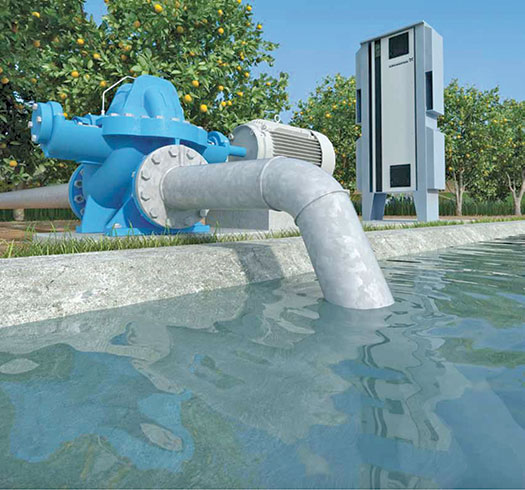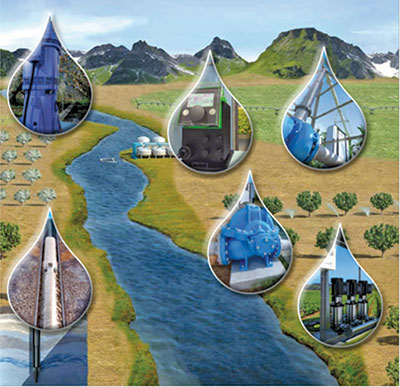Pumps & Systems, March 2013
Modern agricultural irrigation is a complex interplay of sustainable energy consumption, water use, market conditions, and the application of experience and knowledge to ensure the best design for irrigation applications. Understanding past practices, current water and energy issues, and developments in pump technology contributes to building pumping systems that best service the needs of modern agriculture. The agricultural market is changing rapidly, and farmers cannot rely on the technology and practices of the past.
To keep productivity high and stay competitive in the market, farmers need to focus on profitability, which includes energy optimization and better use of water resources. Pumping systems play a vital role in providing optimized solutions for energy and water use.

A pump system for today’s irrigation is not only about the pumps. Variable speed drives, intelligent control and remote management all necessitate the integration of components in an irrigation system.
What Is Irrigation?
Irrigation is an artificial application of water to plant roots with the purpose of assisting the growth of agricultural crops. Fertilizer and chemicals can be added to an irrigation system. Irrigation can also play a role in frost protection.
Successful agriculture depends on farmers having sufficient access to water. In the middle of the last century, the common perception was that water was an infinite resource. Today, we know that water is a resource that must be managed. This is not only a question of more mouths to feed—people consume more calories and eat more meat. This requires more water to produce food.
Farmers must consider energy consumption. Energy for irrigation pumps is one of the highest single cost drivers for farmers. However, many are unaware of the potential savings from more effective and efficient energy use.
Modern agriculture requires irrigation solutions that optimize uniformity, reduce energy costs, safeguard the water resource and keep productivity at its best. The agricultural market changes require greater focus on applying knowledge, experience and total irrigation solutions integrating all components.
What to Consider When Getting Water to the Crop?
Irrigation starts with sourcing water for the crop from groundwater or surface water from a channel or storage pond. Next is water treatment, if necessary, and perhaps the addition of fertilizer or chemicals. Finally, water is delivered to the crop using different techniques—such as flooding, sprinkler irrigation or drip/micro-spray applications.
Mechanized sprinkler systems, such as pivot irrigation, are effective for covering large areas. These systems are typically attached to a pump that can supply the necessary amount of water, pressure and significantly more, as a precaution. A valve handles the excess flow and pressure.
Drip and micro-spray irrigation are used for low-pressure applications in which reducing as much potential evaporation and run-off as possible is a requirement. Keeping the pressure constant is vital to ensure uniform application throughout each zone in the system. This can be the most energy-efficient method of irrigation, if managed properly. Achieving this requires that the system be able to compensate for variations in flow to ensure constant pressure as zones cut in and out.
Traditional Approaches and Pumping Solutions
Groundwater withdrawal has typically involved submersible or vertical turbine pumps that bring water to the surface. For surface water intake, centrifugal pumps in different configurations, split case pumps and end suction pumps have been traditional solutions.
These pumps are required to meet changing conditions above and below ground, which have an effect on the pressure and flow required from day to day and from season to season. A pumping system must deliver the right amount of pressure and flow at the nozzle. The simple solution is to oversize the pump, so the pump is able to handle a worst case scenario. However, as a result, the pump will almost never operate at its optimal duty point. It will produce too much pressure and consume too much energy, which is not used productively in any way.
Traditionally, water has been distributed from the water source—either groundwater or surface water—at low or constant pressure from pumps operating at single speed. Delivery to the crop has been from nozzles, where the focus has been on surface coverage, without much attention placed on run-off, canopy evaporation and wind drift. Soil moisture monitoring to ensure an even spread over the irrigated area is a relatively new discipline.
In contrast, pressure management has long been an issue. Through the years, pressure reduction valves have been used to reduce pressure in the system. However, valves are costly to install and require frequent service and replacement, and their operation consumes a lot of energy.
If end users think of an agricultural irrigation system as a car and the pump as the motor, would it make sense to drive the car at constant full throttle and control the speed with the brakes? This is a common approach for irrigation pumps.
Meeting the Challenges of Modern Agriculture
Complete pumping systems instead of large, isolated pumps are the solution going forward. For example, the costly and time-consuming use of pressure reduction valves to maintain constant pressure can be eliminated by investing in pump controllers for effective pressure management. This saves costs in the long term, reduces the need for service and minimizes energy consumption.
The same can be said of using valves in sprinkler irrigation. Using a variable speed pump and a pressure sensor on the pivot, which would automatically adjust the pump performance to match the requirements for the pivot, is a much better approach. This would ensure higher irrigation uniformity and keep energy costs down. A pump controller offers the additional advantage of protecting the pump from dry-running or power supply irregularities, which will extend the lifetime of the pump.
The rises and falls in water level, below ground and for surface water, essentially change the specifications for a pumping system because these variations change the head. A single speed pump dimensioned to lift from the lowest water level will burn energy dollars when the level is high. On the other hand, a variable speed pump adjusts its head and flow to compensate for water level changes, reducing energy costs.
Designing an Irrigation System for Today’s Applications
Farmers and pump system providers need to think through the specific irrigation applications in new ways, and in particular they need to think about irrigation system design in the application. The pumps must be much more integrated with the rest of the irrigation system. This means the pump must be designed to match the irrigation equipment or the irrigation equipment must be designed to match the pump.

The range of pump applications in agricultural irrigation is many and varied. The key to success is intelligent pump controls that are designed specifically for each application.
The current approach of simply installing a pump capable of always delivering more than enough water ends up wasting money and energy. Returning to the aforementioned metaphor, which compares the system to a car and the pump to its motor: Purchasing an over-sized motor to place in a car will end up a costly affair and offers no guarantee of a comfortable or fuel-efficient ride.
Think about this in an irrigation system, in which the pump must do more than simply deliver water to the pipes to be effective. For example, adding variable speed drives improves the efficiency of groundwater withdrawal when pumping directly into an irrigation system. Surface water intake and distribution can be improved by using multi-pump pressure boosting systems. Across the board, monitoring and control systems further safeguard the reliable flow of water by protecting the pump from dry-running, motor breakdown or power supply irregularities.
All these elements must be fully integrated into the design to provide the benefits that a modern irrigation pump system can offer the farmer. Maintaining correct pressure and flow in the pipes and at the nozzle means more water per kilowatt hour and savings on energy, which is one of the highest cost items in farming.
Earlier, the importance of maintaining a constant pressure in a pivot irrigation system was explained. This becomes relevant if the pivot is equipped with an end gun and maybe even a corner section. As soon as the end gun or corner section comes on, the pressure in the pivot’s main line will drop. This will impact the irrigation uniformity.
The solution is to replace the pivot’s main pump with a variable speed pump, which will immediately react to a pressure drop when an end gun or corner section cuts in. In such a configuration, it is possible to maintain the same pressure on all the sprinklers and, therefore, deliver high uniformity (see Figure 1).
.jpg)
Figure 1. If a pump is specified to run continuously at the highest level—for example when the corner section comes on—energy is wasted. The different requirements for optimal energy use on a pivot application can be met by using a variable speed pump. This offers substantial energy savings while maintaining pressure requirements.
The Future: Total Solutions, Tailored to the Application
The development in irrigation systems described in this article reveals a need for careful consideration of the entire irrigation system and each component’s integration, tailored to the application.
This requires experience and knowledge. The ability to follow water from the source to the crop—from water intake, water treatment and distribution to the irrigation application—and carefully monitor it along the way is critical for an irrigation pump system.
Modern agriculture requires a broader understanding of component integration, and the system must ensure that the farmer is able to respond to issues of energy consumption and water supply, specifically by isolating areas in which savings can be made, generating increased profit per acre.
This is not an exercise that can be carried out in isolation. All relevant local conditions must be added to the equation—such as soil conditions, the crop, topography and weather patterns. Pump control, including monitoring and intelligent management, is then the way forward.
Energy savings are there to be made and are substantial. The added benefit for the farmer is, in addition to the lower operating costs, that water is delivered with greater precision to the crop. This results in a better harvest, increased profitability and better water management, ensuring sustainable agriculture in the future.

